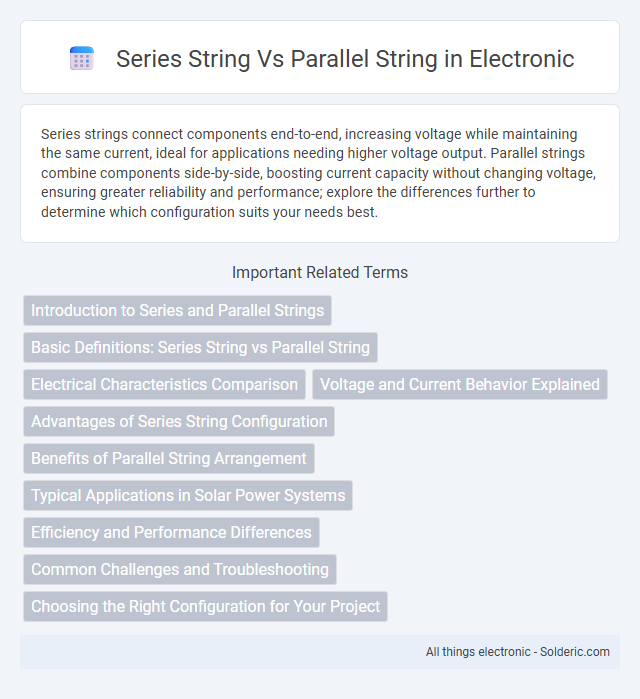Series strings connect components end-to-end, increasing voltage while maintaining the same current, ideal for applications needing higher voltage output. Parallel strings combine components side-by-side, boosting current capacity without changing voltage, ensuring greater reliability and performance; explore the differences further to determine which configuration suits your needs best.
Comparison Table
| Aspect | Series String | Parallel String |
|---|---|---|
| Connection Type | Connected end-to-end, voltage adds up | Connected side-by-side, current adds up |
| Voltage | Increases with each added unit (sum of voltages) | Matches voltage of a single unit |
| Current | Same current flows through all units | Sum of currents from each branch |
| Applications | Battery packs, series circuits for higher voltage | Power supply circuits needing higher current |
| Advantages | Simple design, increased voltage | Increased current, redundancy in case of failure |
| Disadvantages | If one unit fails, entire string fails | More complex wiring, voltage imbalance risks |
| Power Output | Power = Voltage x Current (Voltage increases) | Power = Voltage x Current (Current increases) |
Introduction to Series and Parallel Strings
Series strings connect components end-to-end, allowing current to flow sequentially through each element, which impacts overall voltage and system performance. Parallel strings connect components across the same two points, sharing voltage evenly but dividing current among the branches, enhancing system reliability and efficiency. Understanding the distinction between series and parallel strings is crucial for optimizing your electrical or photovoltaic system design.
Basic Definitions: Series String vs Parallel String
A series string is an electrical circuit configuration where components are connected end-to-end, allowing current to flow through one path sequentially, resulting in the sum of voltages across each component. A parallel string consists of components connected alongside each other, providing multiple current paths, where the voltage remains constant across all components but the total current is the sum of individual branch currents. Understanding the differences between series and parallel strings is crucial for optimizing voltage, current, and resistance in electrical systems like solar panels and batteries.
Electrical Characteristics Comparison
Series strings have higher voltage and lower current, making them suitable for applications requiring increased voltage outputs, while parallel strings offer higher current at lower voltage, enhancing system reliability through independent pathways. Electrical losses in series configurations can increase due to voltage drop across components, whereas parallel setups minimize these losses by distributing current evenly among strings. Understanding these electrical characteristics helps you design efficient circuits tailored to your voltage and current requirements.
Voltage and Current Behavior Explained
In a series string, the voltage across each component adds up while the current remains constant throughout the circuit. Conversely, in a parallel string, the voltage across each branch is identical, but the total current is the sum of the currents flowing through each parallel path. This fundamental difference influences system design in electronics and power distribution by determining how voltage and current are managed for efficiency and safety.
Advantages of Series String Configuration
Series string configuration offers increased voltage output by connecting solar panels end-to-end, enabling efficient operation in high-voltage systems and reducing current-related power losses. This setup simplifies wiring and inverter compatibility, leading to lower installation and maintenance costs. Additionally, higher voltage systems improve energy transmission efficiency over long distances, making series strings ideal for commercial solar applications.
Benefits of Parallel String Arrangement
Parallel string arrangements provide increased reliability by allowing circuits to continue operating even if one string fails, enhancing overall system uptime. They maximize current output while maintaining voltage levels, which is ideal for applications requiring consistent voltage with variable current demands. You benefit from easier system expansion and improved performance under partial shading conditions compared to series configurations.
Typical Applications in Solar Power Systems
Series strings are commonly used in solar power systems to increase the voltage output, making them ideal for grid-tied applications and large-scale solar farms where higher voltage reduces transmission losses and improves inverter efficiency. Parallel strings are preferred in residential and commercial solar installations with shading issues, as they maintain system performance by allowing current flow through unaffected strings despite partial shading or panel mismatches. Hybrid configurations combining series and parallel strings optimize both voltage and current, enhancing overall system reliability and energy yield in complex solar arrays.
Efficiency and Performance Differences
Series string wiring results in higher voltage but can suffer from significant efficiency losses if one panel underperforms or is shaded, reducing the performance of the entire array. Parallel string configurations maintain voltage levels while increasing current, allowing your solar system to perform more consistently under partial shading or panel mismatch, enhancing overall efficiency. Choosing the right setup depends on balancing voltage and current requirements to optimize your renewable energy system's performance.
Common Challenges and Troubleshooting
Series string configurations often face voltage mismatch issues and increased vulnerability to shading, while parallel string setups struggle with current imbalances and complex wiring faults. Troubleshooting series strings involves checking for hotspot development and voltage drops, whereas parallel strings require careful inspection of connector integrity and consistent current flow across branches. Understanding these challenges helps you optimize system performance and quickly identify faults in solar panel arrays.
Choosing the Right Configuration for Your Project
Selecting the appropriate configuration between series string and parallel string depends on your project's voltage and current requirements. Series strings increase voltage while maintaining current, ideal for systems needing higher voltage input, whereas parallel strings increase current while keeping voltage constant, suitable for applications demanding higher current capacity. Understanding your load specifications and inverter compatibility ensures optimal performance and efficiency for your solar power installation.
Series string vs parallel string Infographic

 solderic.com
solderic.com